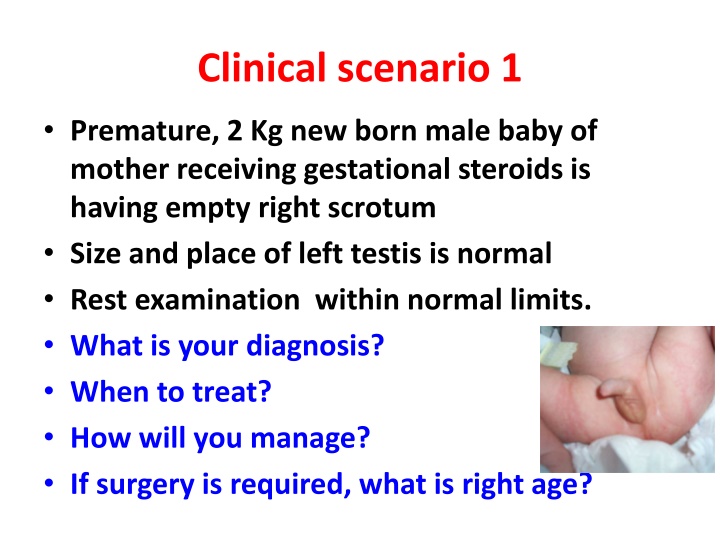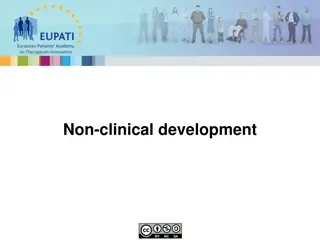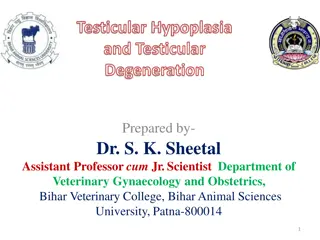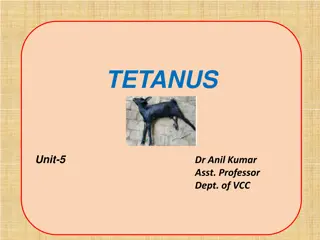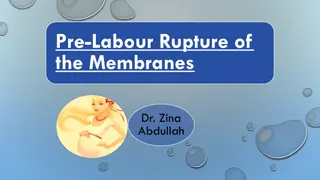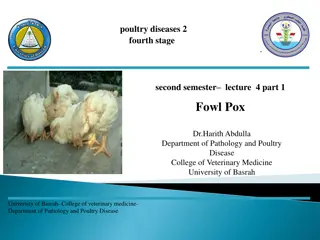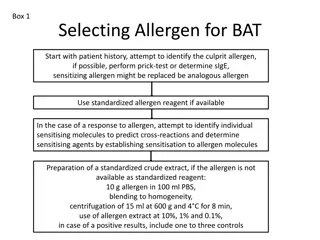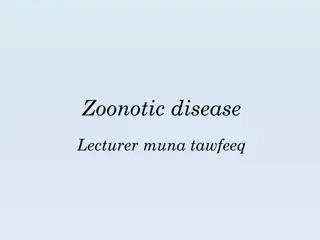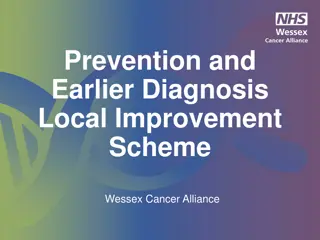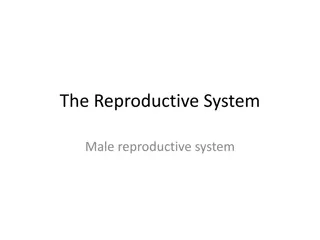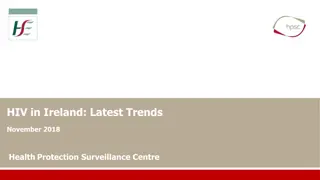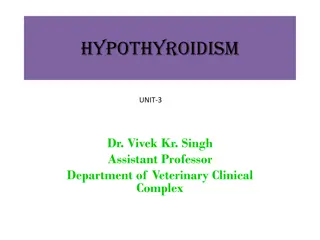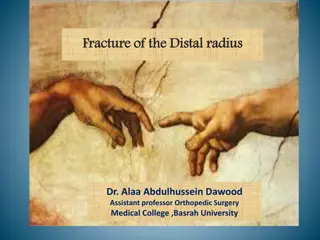Undescended Testes: Clinical Scenarios, Diagnosis, and Management
Premature newborn with an empty right scrotum and a 30-year-old male presenting with an intra-abdominal lump and an empty right scrotum raise concerns of undescended testes, necessitating proper diagnosis and management. Understanding the embryology, clinical presentations, treatment options, and potential complications associated with undescended testes is crucial for healthcare providers dealing with such cases.
Download Presentation

Please find below an Image/Link to download the presentation.
The content on the website is provided AS IS for your information and personal use only. It may not be sold, licensed, or shared on other websites without obtaining consent from the author.If you encounter any issues during the download, it is possible that the publisher has removed the file from their server.
You are allowed to download the files provided on this website for personal or commercial use, subject to the condition that they are used lawfully. All files are the property of their respective owners.
The content on the website is provided AS IS for your information and personal use only. It may not be sold, licensed, or shared on other websites without obtaining consent from the author.
E N D
Presentation Transcript
Clinical scenario 1 Premature, 2 Kg new born male baby of mother receiving gestational steroids is having empty right scrotum Size and place of left testis is normal Rest examination within normal limits. What is your diagnosis? When to treat? How will you manage? If surgery is required, what is right age?
Clinical scenario 2 30 year old male presents with mild pain and intra-abdominal lump in right lower abdomen O/E Lump is hard, non tender, irregular, fixed, not moving with respiration Right scrotum is empty What is the diagnosis and why? How will you manage?
Undescended testes Prof. Vinod Jain
Learning Outcomes Be able to understand embryology of testicular descent & its application Be able to suspect diagnosis based on clinical presentations Be able to confirm diagnosis Be able to prescribe correct treatment Should understand logical approach of management Be acquainted with complications
Learning resource material Baily and Love s Short practice of surgery (27th edition) Campbell Walsh Urology (12th edition) www.clinicaluptodate.com www.clinicalkey.com
Undescended Testes Testicular embryology and normal descent Time table of testicular descent Incidence Classification Theories of maldescent Endocrine factors Gubernacular factors Intra abdominal pressure
Undescended Testes Histopathology Clinical features Hazards of incomplete descent Investigations Treatment Hormone therapy Surgical treatment
Embryology of testicular descent SRY gene located on short arm of Y chromosome is responsible for testicular differentiation in 7thweek of gestation Testosterone from leydig cell and mullerian inhibiting substance (mis) from sertoli cells of fetal testes in 8thweek initiate and sustain normal male development, independent of pituitary hormone regulation
Time table of testicular descent In lumbar region 2ndmonth of fetal life In iliac fossa 3rdmonth At deep inguinal ring till 7thmonth Travels inguinal canal in the 7thmonth At superficial ring 7th 8thmonth Scrotum (final position) 9thmonth
Incidence Isolated cryptorchidism most common congenital anomaly at birth in male newborns Affects 3% of full term male newborns Unilateral is more common than bilateral Right side more common then left side 70-77% descend spontaneously by 3 month of age Incidence declines to 1% by 1 year of age and remains constant
Classification Intra-abdominal Intracanalicular Extracanalicular Suprapubic Infrapubic Kaplan Palpable 80% Nonpalpable 20%
Factors for late testicular descent Low birth weight - Principal determinant at birth Preterm birth delivery, small for gestational age Twin neonates Cola consumption during pregnancy Preeclampsia Breech presentation Complicated delivery Familial factors
Gubernaculum and testicular descent Gubernaculum develops in 7thweek Important role in fixation of testis to inguinal canal before descent Definite role in descent is not obvious (testis can not be pulled to the scrotum) Testicular descent is a complex process, mediated by both hormonal and mechanical factors
Testicular Descent Testosterone and DHT necessary for descent in inguino-scrotal phase (2ndphase) Descendin an androgen independent factor (gubernacular specific growth factor) Lowered intra-abdominal pressure Prune belly syndrome exomphalos
Histopathology Changes are evident between 1-2 years of age Changes include Decreased number of leydig cells Degeneration of sertoli cells Delayed appearance of adult dark (AD) spermatogonia Failure of primary spermatocyte to develop Reduced total germ cell counts
Clinical features Absent testis in normal position Soft and small if palpable May be associated with hernia or hydrocele Preterm and maternal history Gestational steroids Family history Documentation of undescended testis at the time of birth
Terms in undescended Testis Non-palpable Vanishing Atrophic Retractile
Hazards of incomplete descent Infertility Pain due to trauma Associated indirect inguinal hernia Testicular torsion Testicular atrophy Testicular tumour
Investigations Radiology USG, CT Scan, MRI, herniography Endocrine evaluation FSH, LH, HCG, Testosterone, DHT hCG stimulation test
hCG stimulation test Baseline testosterone level hCG 2000 units daily x 4 days Estimate testosterone on 5th day 10 times increased testosterone if testes are present
Management aims Proper identification of anatomy, position and viability of undescended testis Timely placement of testis with in scrotum to further prevent impairment in fertility potential or endocrine function (6 month to 1 year) Permanent fixation for easy palpation No further testicular damage resulting from the treatment
Hormone therapy Exogenous hCG (Structurally analogue to LH) stimulates leydig cells directly to promote secretion of testosterone Exogenous GnRH or LHRH Stimulates pituitary to release LH promotes testicular testosterone production Lower the pretreatment level better the success rate
Hormone therapy Optimal age is 5 years More effective in bilateral than unilateral Exogenous hCG 1500 IU/M2 IM twice a week for 4 weeks Exogenous GnRH 1.2 mg / day nasal spray for 4 weeks Testis will descent in a month time in 10-20%
Hormone therapy Not indicated in Patients with previous surgery for testis Patients with inguinal surgery Immune suppressed patients Overall efficacy <20% Significantly dependent on pretreatment testicular location Surgery remains gold standard treatment
Surgical treatment Standard orchiopexy Laparoscopic orchiopexy Microvascular auto transplantation Contra-lateral orchiopexy (prophylactic)
Surgical treatment standard orchiopexy Key steps - Complete mobilization of testes and spermatic cord Repair of procesus vaginalis by high ligation of hernia sac Skeletonization of spermatic cord without sacrificing vascular integrity Creation of superficial pouch in hemiscrotum
Complications of orchiopexy Testicular retraction Heamatoma formation Wound infection Ilioinguinal nerve injury Post operative torsions Damage to vas deferens Testicular atrophy
Indication of Orchiectomy In post pubescent males with Contralateral normally descended testis and morphologically and anatomically abnormal cryptorchid testis Too far from scrotum to be placed without compromising the vascular supply
Interdisciplinary Linkage? Surgery/Urology Pathology Radiodiagnosis and nuclear medicine Radiotherapy Surgical oncology Medical oncology Paramedics and health workers
Let us revise Testicular embryology and normal descent Time table of testicular descent Incidence Classification Theories of maldescent Endocrine factors Gubernaculum factors Intra abdominal pressure Histopathology Clinical features Hazards of incomplete descent Investigations Treatment Hormone therapy Surgical treatment
Clinical scenario 1 Premature, 2 Kg new born male baby of mother receiving gestational steroids is having empty right scrotum Size and place of left testis is normal Rest examination within normal limits. What is your diagnosis? When to treat? How will you manage? If surgery is required, what is right age?
Clinical scenario 2 30 year old male presents with mild pain and intra-abdominal lump in right lower abdomen O/E Lump is hard, non tender, irregular, fixed, not moving with respiration Right scrotum is empty What is the diagnosis and why? How will you manage?
